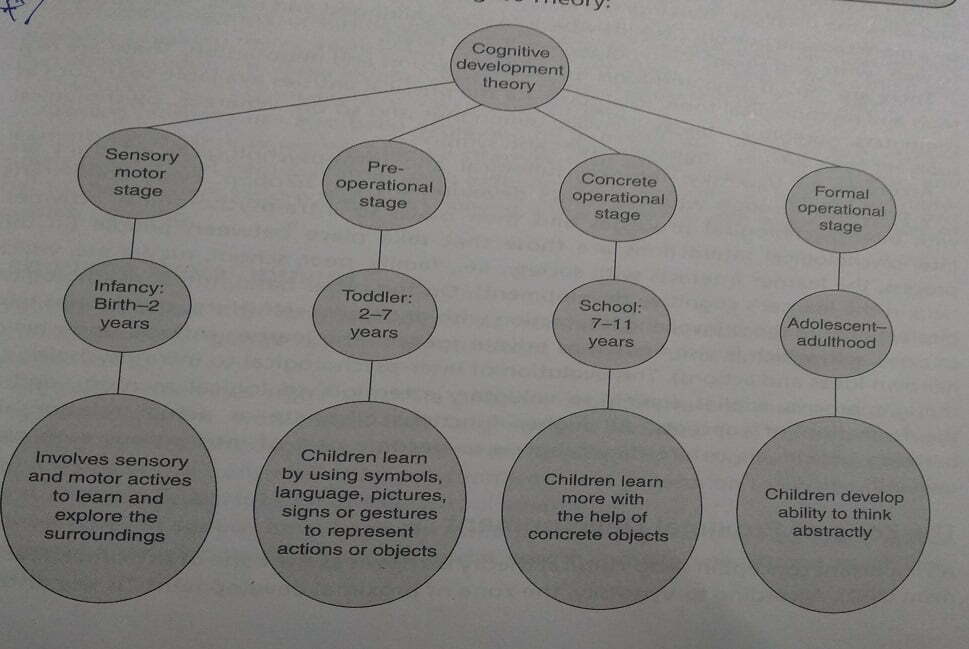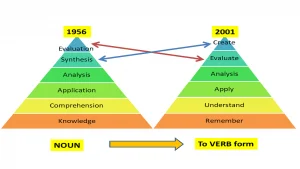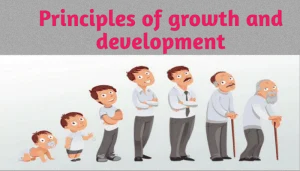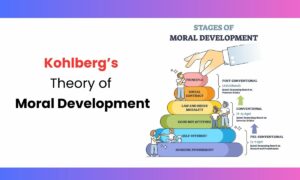Jean Piaget is a Swiss-born psychologist who was the first to make a systematic study of the acquisition of understanding in children. He was Zoologist by profession, He started working with Alfred Binet on Intelligence tests and because of his interest, he also studied child development with a focus on cognitive development. Piaget is also known as a radical Constructivist
Piaget has explained and discussed the different stages of cognitive development. He believed that cognitive development takes place through four fundamental stages. All children have to pass through these stages to reach the next higher level of cognitive thinking.
Piaget’s theory of Child Development
Some of the important factors that influence how children learn and grow:
- Schema: Schema describes both the physical and actions involved in understanding and knowing. According to Piaget, we have a system for organizing information in our mind and we do organize information and experiences in our mental system under different categories. The Mental System and the categories are known as schema
- Adaptation: According to Piaget how we adjust to the environment and called the process of adaptation. Adaption has two subprocesses these are:
- Assimilation: The process of taking new information and fitting the new knowledge or information into the existing schema
- Accommodation: It involves changing or altering existing schema in the light of new information. Sometimes we see that the existing schema does not support new information. In such a situation, we generally do two things. Firstly we alter the existing schema and secondly, we create a new schema. This process is known as Accommodation
- Equilibration: The ongoing process through which a child tries to create a balance between Assimilation and Accommodation. This process is known as equilibration
Piaget’s Stages of Child Development
Jean Piaget’s theory of Cognitive Development is divided into four major stages are:
| Stages | Age | |
| 1 | Sensory Motor | 0-2 |
| 2 | Preoperational | 2-7 |
| 3 | Concrete Operational | 7-11 |
| 4 | Formal Operational | 11-16 |

The Sensory Motor Stage
Ages: Birth to 2 years
The main characteristic of this stage of development are:
- It involves the senses and motor activities.
- Children do reflexive activities such as sucking and grasping.
- The child observes and imitates his or her surroundings. Thought and memory also start to develop systematically.
- Children learn to recognize objects and understand that objects have their separate permanent existence
- As infants grow older, they learn that even if an object is not in front of them, it still exists. Piaget called it to object permanence. It is also known as ‘out of sight, out of mind
- Children also learn to work in a particular direction. Catching a particular thing that they are asked to catch, playing with puzzles, and so on are common activities they learn to do. They move from simple to complex logical actions and thinking. This goal-directed thinking helps them to progress to a higher level scheme to achieve a goal.
The Sensory Motor Stage is further divided into six sub-stages
There are six sub-stages of the first stage given by Piaget:
- Stages of Reflex Activities (0—1 month): Inborn reflexes (sucking and looking) help the child to understand the surrounding.
- Primary Circular Reactions (1—4 months): Sensations and schemas get coordinated in this stage. Whatever children do in this stage, they tend to do it repeatedly as they derive pleasure from doing so. For example, if a child starts sucking thumb, he or she will continue with this action because it gives the child a soothing feeling.
- Secondary Circular Reactions (4—8 months): younger Children become more focused on doing actions. They repeat their actions to get a response from the environment.
- .Coordination of Reactions (8—12 months): In this stage, children learn to make a difference between goal and means. They also develop ways to achieve their goals. They also try to generalise the learning and try to use it from one situation to another.
- Tertiary Circular Reactions (12—18 months): This is a stage of trial and error. Children explore the things around them. They make mistakes and also tend to repeat these mistakes. This stage is very important as children learn to be confident in this particular stage. They repeat many actions because they want attention from their caregiver.
- Early Representational Thought (18—24 months): Children start focusing more on mental activities rather than physical actions and they start thinking about objects. At this age, they show the ability to recognize object permanence. They search for the toy even if it is not in their sight.
The Preoperational stage
Ages: 2 to 7 Years
The Main Characteristics of the stage involve:
- Children begin to process their thoughts at this stage although in a manner that is far less efficient than the logical thought-processing of adults.
- Their vocabulary expands and develops during this time because they change their working style and habits and start behaving like little adults
- This stage is known as a pre-operational stage of cognitive development. It is called ‘pre’ because, in this stage, children cannot perform a logical operation.
- This stage is categorized into two parts. pre-conceptual stage (2-4) and intuitive stage (4-7).
- Their vocabulary expands and develops during this time because they change their working style and habits and start behaving like little adults.
Some of the other important characteristics are:
- Ego-centrism is one of the main characteristics of pre-operational. Children focus on their perspectives and feel that they are correct. They also believe that others also share the same perspective because they think that it is the only perspective that exists. But gradually they understand that there are many perspectives and Piaget called it ‘decentering: They start believing that they are not at the center of everything.
- Animism is also a characteristic of the pre-operational stage. It is a characteristic by which children believe that all objects or things are living and have some consciousness. An example of this is that children often believe that a table also feels pain if it is hit or kicked; a car does not get started because it is tired and so on. A child believes that everyone is like him or her.
- Children also develop the ability to use symbols, language, pictures, signs or gestures to represent actions or objects mentally. Piaget called this semiotic function or symbolism. Along with this, their ideas of right and wrong are governed by the people around them.
- They generally focus on one aspect at a time and cannot think of any Other possible situation. This is called moral realism. This moral realism makes them believe and respect rules and authority. children are not equipped for certain functions at this stage.
- For example, they cannot do reversible thinking. While children can do simple logical operations, they face difficulty in understanding reverse counting, extended family relation tree and so on. Along with reversibility, they also face difficulty in the conservation of various concepts such as height and width. Conservation is a principle according to which some characteristics of an object remain the same despite the change in its appearance.
- A famous example of conservation is that regarding the conservation of volume, where children said the glass with more height has more water than the other glass, although the volume of water was the same in both glasses. Such examples show that children can think only in one direction and face difficulty in the conservation of various concepts
The Concrete Operational Stage
Ages: 7 to 11 years
The main characteristic of the Concrete Operational stage are:
- Children can do operations on concrete objects and situations. However, they will find it hard to solve abstract problems and have difficulty with words like ‘assume’ that relate to mental conjecture.
- They can do logical thinking if they are allowed to manipulate objects. By comparison, however, it is seen that thoughts can be manipulated and the presence of the object is not necessary for the thought to take place in the formal operations stage.
- They start thinking more like mature persons and rarely believe in animism and ego-centrism.
- However, there may be a few exceptions where some children continue to hold on to these fixations as do some people who carry them well into their adulthood. During the concrete operational stage, children gradually develop the ability to conserve or learn that objects are not always the way that they appear to be. They start taking many perspectives about concepts. They begin to develop the ability to Understand identity, compensation, and reversibility.
- Once children have learned to conserve, they also learn that objects remain the same even after changes in colours, etc.
- For example, they learn that if they spread out the pencils on the floor, there are still as many as there were before, even though they look different!
- Children learn many things in this stage concerning conservation such as classification, grouping objects into categories, seriation, and arranging of objects in sequential order according to one aspect, such as size, weight or volume
The Formal Operational Stage
Ages: 11 years to Adulthood
The Main Characteristics of the formal operational stage are:
- This is the final stage of Piaget’s cognitive development in this stage
- Children become capable of abstract thinking and can understand the combination and coordination of numbers and variables.
- Developed formal operational thought.
- Children move ahead from concrete objects to abstract concepts
- They develop a logical system of intelligence and try to incorporate all possible solutions while working on a problem.
- They also learn to coordinate between different variables.
- Children in this stage use the formal operations problem-solving strategy in which an individual begins by identifying all the factors that might affect a problem and then deduces them systematically. Piaget called it hypothetico-deductive reasoning.
- This stage permits adolescents to reason beyond a world, of concrete reality to a world of possibilities. Sometimes, they just live in a world of imagination with no concern about the real world.
- Piaget believes that children overcome egocentrism, but they still tend to believe that everyone shares similar thoughts, feelings and concerns. They wonder why people do not understand their needs and perspective and therefore, they develop adolescent ego-centrism. They feel that everyone notices them, what they do, how they walk, how they talk, and so on.
- Piaget said, children, develop an imaginary audience and think they are being observed by people. They spend a long time in front of the mirror before they go out
Educational Implications of Piaget’s Theory of Cognitive Development
- Discovery Learning: According to Piaget Children Construct their own knowledge through experience. Learning should be focused on the Discovery approach to Learning.
- Problem-Solving: In a classroom more and more problems solving activities should be given to children so that they can gain experience through activity and Develop problem-solving skills.
- Project Method: It encourages Learning by doing. The project should be given to children
- Activities-based Learning: Co-curricular activities are equally important as that curricular experience in the cognitive development of children.
- Teacher as Facilitator: The teacher’s role is to guide children as an instructor, children construct their own knowledge.
- Individual Differences: Every child is different from one another. Learning should be provided according to their age, abilities and interest. Piaget stages of child development help to identify their individual difference.
- Readiness To learning: Providing a Learning Experience in tune with the mental abilities of the children. Children should be ready to learn mentally E.g: we cannot give algebra to primary children because their cognitive ability is not ready to learn algebra
- Curriculum Development: Piaget’s Theory of Cognitive Development provides valuable information regarding curriculum planning and Curriculum development according to the need, interests and abilities of children. E.g. Class-I children learn through pictures, more diagrams and pictures should be included in the textbook and Teaching-Learning Process
- Teaching Method: The teaching method must be simple to complex and the inclusion of a project teaching method is recommended
- The goal of education: The major goal of education should be equal to creative and critical thinking Development.
Criticism of Piaget’s Theory of Cognitive Development
The criticism of Piaget’s theory is-
- Piaget believes that object performance behaviour starts developing at about seven months of age. But later research shows object performance behaviour begins at about four months of age.
- Piaget ignores the influence of sociocultural factors on cognitive development
- Piaget ignores the effect of training He believes in Biological Maturation but later research found that Children in the pre-operational stages can be trained to decenter (think of objects and events independent of their immediate experience) and to be less egocentric.
- The trouble with stages-According to Piaget Development occurs in stages but later found that development is a continuous process. Research shows that the upper age limit suggested by Piaget for the concrete operational stage extends beyond 11 years. More than 75% of children remain concrete thinkers at 12 years, 13 years and 14 Years. About 40% of the 12th graders are primarily concrete thinkers.
- The piaget theory does not address the cognitive development of exceptionally talented individuals.
- Another criticism is that the end point of cognitive development is too limited. Piaget’s description of formal operational stages is limited to problem-solving. Airline (1986) Suggested a stage beyond formal operation characterized by the ability to discover new problem, new solutions and new knowledge
Conclusions
In Conclusion, Piaget’s theory of cognitive development is one of the most important theories of child development. This theory helps the teacher to know the ability of children and their mental ability with the help of this theory teachers can develop effective curricula and Methods of teaching according to their ability and interest. however, Many psychologists criticize Piaget’s cognitive development theory.
Reference:
Kumar, S. (2019). CTET-Central Teacher Eligibility Test: Child Development and Pedagogy. (6th ed., pp. 36-43). Uttar Pradesh, India: Pearson India Education Service Pvt. Ltd.
Frequently Ask Questions (FAQ)
What are the 4 stages of cognitive development?
The four stages of Piaget’s Cognitive developmental theory are:
Sensory Motor Stage: (0—2 Years), Preoperational stage: (2—7 Years), Concrete Operational Stage: (7—11 Years) and Formal Operational Stage: (11 Years —Adulthood)
Why the Piaget’s theory of cognitive development is important?
Piaget’s theory gives us an idea of how children gain knowledge and develop thinking processes. We can prove a suitable environment to draw out the maximum growth and development of children and it also helps for teachers to develop curriculum and methods of teaching according to their needs and ability.
What is cognitive development in simple terms?
Cognitive development in simple terms is mental development or developed the thinking process of children



